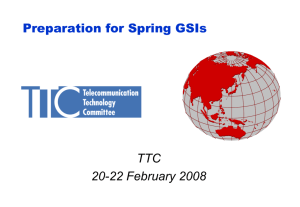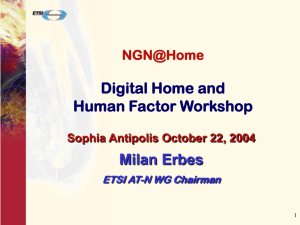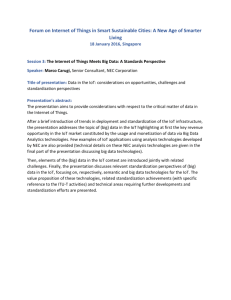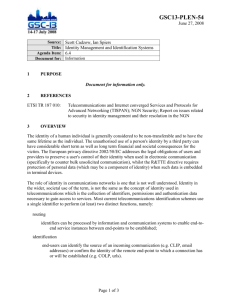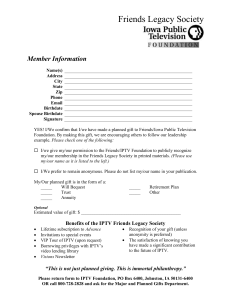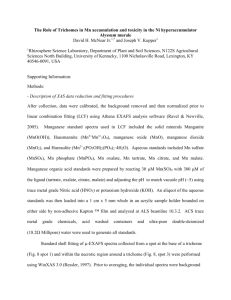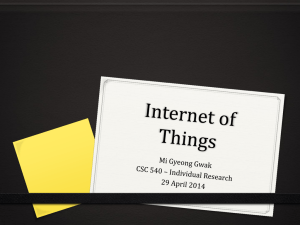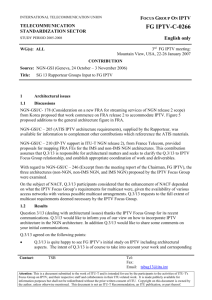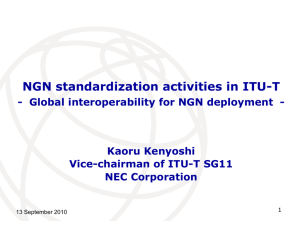(NGN) (June 2012 Issue)
advertisement
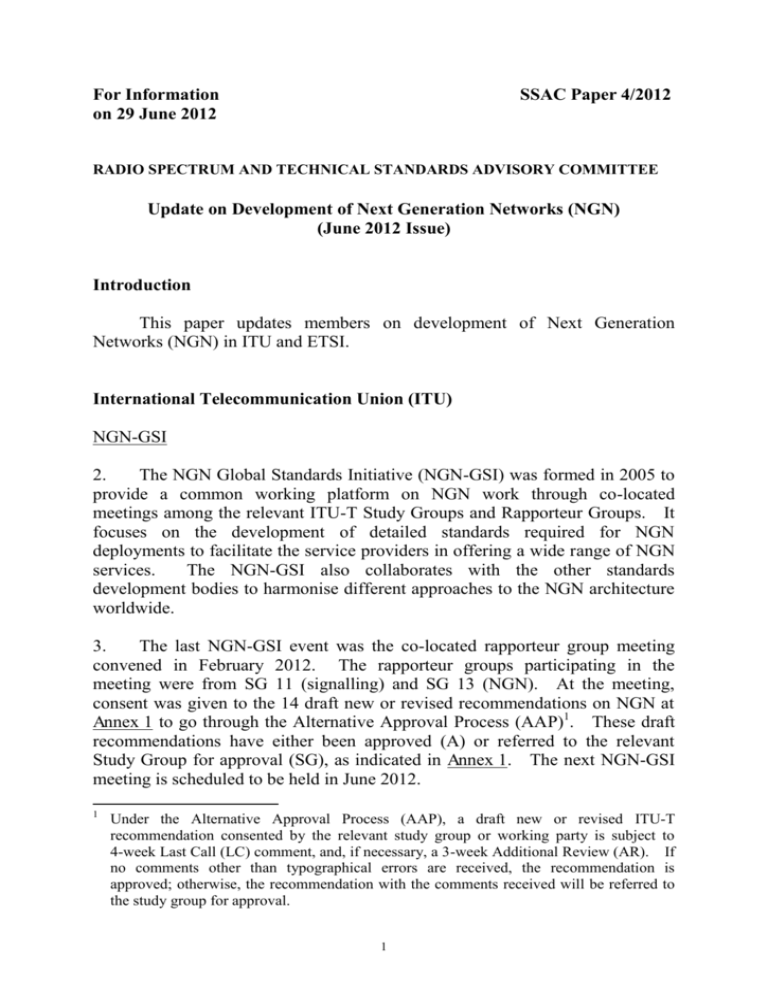
For Information on 29 June 2012 SSAC Paper 4/2012 RADIO SPECTRUM AND TECHNICAL STANDARDS ADVISORY COMMITTEE Update on Development of Next Generation Networks (NGN) (June 2012 Issue) Introduction This paper updates members on development of Next Generation Networks (NGN) in ITU and ETSI. International Telecommunication Union (ITU) NGN-GSI 2. The NGN Global Standards Initiative (NGN-GSI) was formed in 2005 to provide a common working platform on NGN work through co-located meetings among the relevant ITU-T Study Groups and Rapporteur Groups. It focuses on the development of detailed standards required for NGN deployments to facilitate the service providers in offering a wide range of NGN services. The NGN-GSI also collaborates with the other standards development bodies to harmonise different approaches to the NGN architecture worldwide. 3. The last NGN-GSI event was the co-located rapporteur group meeting convened in February 2012. The rapporteur groups participating in the meeting were from SG 11 (signalling) and SG 13 (NGN). At the meeting, consent was given to the 14 draft new or revised recommendations on NGN at Annex 1 to go through the Alternative Approval Process (AAP)1. These draft recommendations have either been approved (A) or referred to the relevant Study Group for approval (SG), as indicated in Annex 1. The next NGN-GSI meeting is scheduled to be held in June 2012. 1 Under the Alternative Approval Process (AAP), a draft new or revised ITU-T recommendation consented by the relevant study group or working party is subject to 4-week Last Call (LC) comment, and, if necessary, a 3-week Additional Review (AR). If no comments other than typographical errors are received, the recommendation is approved; otherwise, the recommendation with the comments received will be referred to the study group for approval. 1 IPTV-GSI 4. The IPTV Global Standards Initiative (IPTV-GSI) was set up in 2008 to provide a single location for information on and coordination of the development of IPTV standards. It aims to accomplish the following objectives through meetings and related activities involving Rapporteur Groups of the relevant ITU-T Study Groups (SG) working on IPTV – (a) to provide a common working platform through co-located meetings among IPTV related rapporteur groups; (b) to develop the detailed standards necessary for IPTV deployments; and (c) to harmonise, in collaboration with other standards development bodies, different solutions for IPTV worldwide. 5. The last two IPTV-GSI events were the co-located rapporteur group meetings held in February and April/May 2012 respectively. The participating rapporteur groups participated in the events were from SG 9 (cable networks and TV/sound transmission), SG 11 (signalling), SG 13 (NGN), SG 16 (multimedia terminals and applications), and SG 17 (security). The meeting made progress in the drafting of the IPTV recommendations including those on information delivery framework for IPTV, audience measurement for IPTV services, IPTV terminal devices, and multimedia content provisioning interface for IPTV. The next IPTV-GSI meeting will be held in September 2012 in the USA. IoT-GSI Event 6. The Internet of Things Global Standards Initiative (IoT-GSI) was established in 2011 to promote a unified approach in IoT standardisation and to provide a visible platform for IoT-related work across rapporteur groups of the relevant ITU-T study groups. The participating study groups of the IoT-GSI include SG 11 (signalling), SG 13 (future networks and NGN), SG 16 (multimedia coding, systems and applications) and SG 17 (security). Like the other GSI, the IoT-GSI will collaborate with other standards development bodies to ensure global harmonisation to the various approaches to the IoT architecture. Specifically, IoT-GSI aims to accomplish the following objectives through meetings and related activities (a) to develop a definition of “Internet of Things (IoT)”; (b) to provide a common working platform through co-located meetings of the IoT-related rapporteur groups; and 2 (c) to develop the detailed standards required for IoT deployment, taking into account the work done in other standards development bodies. 7. Since its establishment, the IoT-GSI has convened five meetings, focusing on several study items, including the development of – (a) a recommendation on IoT overview to clarify the scope of IoT, its high level requirements, key features for services and devices, etc.; (b) a recommendation on IoT terminology which includes a definition of IoT; and (c) a work plan which identifies on-going and new study items on IoT. Work on these study items has made good progress. At the last IoT-GSI meeting held in May 2012, it was agreed to initiate work on a new study items on IoT service requirements. The relevant study groups responsible for this study item are SG 13 and SG 16. These study groups will progress their respective work related to IoT requirements with the understanding of the need to ensure coordination in the future when they have more concrete content on their work. European Telecommunications Standards Institute (ETSI) Internet of Things CoAP Plugtests 8. The first Internet of Things (IoT) Constrained Application Protocol (CoAP) Plugtests interoperability event, organised by ETSI, was held in late March 2012 in France. CoAP is a lightweight application protocol developed by the Internet Engineering Task force (IETF) for wireless sensors which have limited computing power, memory and radio transmission range. CoAP provides an efficient way to transfer sensor data (e.g. humidity, temperature, location) which can then be translated easily into HyperText Transfer Protocol (HTTP) to allow the integration of sensor data into web-based services, thus facilitating the creation of a true Internet of Things. The CoAP protocol has been selected by ETSI to be part of the ETSI Machine-to-Machine (M2M) architecture. 9. The Plugtests event was attended by 18 companies which tested the world’s first CoAP client and server implementations from China, the European Union, Japan and Korea. It allows vendors to evaluate the interoperability of their products and to verify their understanding of the specifications. Moreover, it provided useful feedback to enhance on-going standardisation work of ETSI and IETF. 3 Adoption of New SIM Card Format 10. At the meeting of ETSI Technical Committee on Smart Card Platform (TC SCP) in May/June 2012, the Technical Committee agreed a new form factor (the fourth form factor, or 4FF) for the Universal Integrated Circuit Card (UICC), which is more commonly referred to as the Subscriber Identity Module (SIM) card for mobile phones. The requirements of the 4FF card will be published by the ETSI in the technical specification TS 102 2212. 11. The 4FF card will be 40% smaller than the current smallest SIM card, at 12.3 mm wide by 8.8 mm high, and 0.67 mm thick. It takes up much less amount of the valuable space inside the mobile devices. The new design is backward compatible with and offers the same functionality as all current SIM cards. The new form factor is adopted by the major mobile network operators, smart card suppliers and mobile device manufacturers. RCS and VoLTE Interoperability Event 12. The MultiService Forum (MSF), ETSI and the GSM Association (GSMA) are organising a Rich Communication Suite (RCS)3 and Voice over Long Term Evolution (VoLTE)4 interoperability test event to be held in October 2012. The test event will take place in two laboratories, one in Slovenia (Kranj) and the other in China (Beijing). 13. The test event aims to validate core network interfaces to facilitate multi-vendor deployment of LTE, Evolved Packet Core (EPC) and IP Multimedia Subsystem (IMS) technologies for RCS and VoLTE services. It will focus on interoperability of RCS services with and without VoLTE, as well as interoperability of VoLTE services in the home/single network scenario and the roaming and interconnect scenario. Testing will include attachment and detachment from the network, tracking area update, SIP registration to IMS, SIP 2 TS 102 221 titled “Smart Cards; UICC-Terminal Interface; Physical and logical characteristics” specifies the requirements for the physical characteristics of the UICC as well as the electrical and communications interface between the UICC and the terminal. 3 RCS is an industry effort focused on the use of IMS for providing mobile phone communications services. RCS enables mobile phone users to use services like instant messaging, live video sharing and file transfer across any device on any network operator, enhanced phone book with service capabilities and presence information. 4 VoLTE is the provision of voice service using the LTE technology over the IMS platform. 4 session establishment, interaction with IMS multimedia telephony, IMS conversational video services and RCS services. Advice Sought 14. Members are invited to note the content of this paper, and provide additional information on the development of NGN. Office of the Communications Authority June 2012 5 Annex 1 List of draft new or revised recommendations on NGN consented at the NGN-GSI meeting of February 2012 Study Group 11 (a) Q.3304.1 v2 Resource Control Protocol no. 4 (rcp4) Protocol at the interface between a Transport Resource Control Physical Entity (TRC-PE) and a Transport Physical Entity (T-PE) (Rc interface): COPS alternative (SG) (b) Q.3307.1 (2009) Amd.1 Amendment to Q.3307.1 Resource control protocol No.7 - Protocol at the interface between inter-domain policy decision physical entities (Ri interface) (A) (c) Q.3308.1 Resource control protocol 8 (rcp8) Protocol at the interface between Resource Admission Control Physical Entity (RAC-PE) and CPN Gateway Policy Enforcement Physical Entities (CGPE-PE) (Rh interface): COPS alternative (A) (d) Q.3314 Requirements and protocol at the interface between mobile location management physical entity used as a proxy and the central instance of the mobile location management physical entity (M9 interface) (A) (e) Q.3613 Signalling requirements for touch screen terminal-based IVR services (A) (f) Q.3925 The types of traffic flows which should be generated for voice, data and video on the Model network for testing QoS parameters (A) (g) X.603 Information technology - Relayed multicast protocol: Framework (A) Study Group 13 (a) Y.2023 Functional requirements and architecture of the Next Generation Network for Multimedia Communication Centre service (A) (b) Y.2060 Overview of Internet of Things (SG) (c) Y.2061 Requirements for support of machine-oriented communication applications in the NGN environment (SG) (d) Y.2062 Framework of object-to-object communication for ubiquitous networking in NGN (A) (e) Y.2080 Architecture of Distributed Service Networking (SG) (f) Y.2810 Mobility Management Framework for IP Multicast Communications in Next Generation Networks (A) (g) Y.3031 Identification framework in future networks (A) 6
